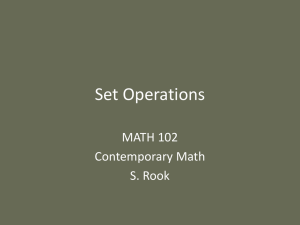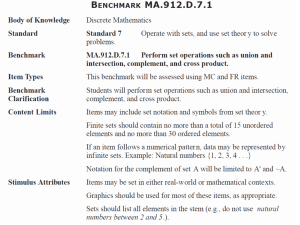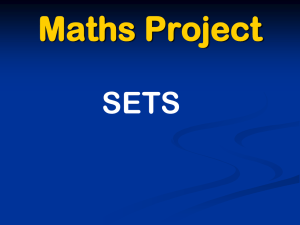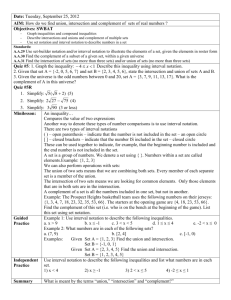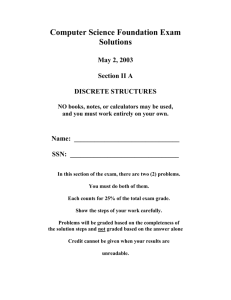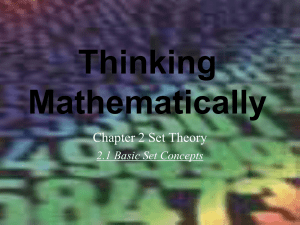slides
advertisement
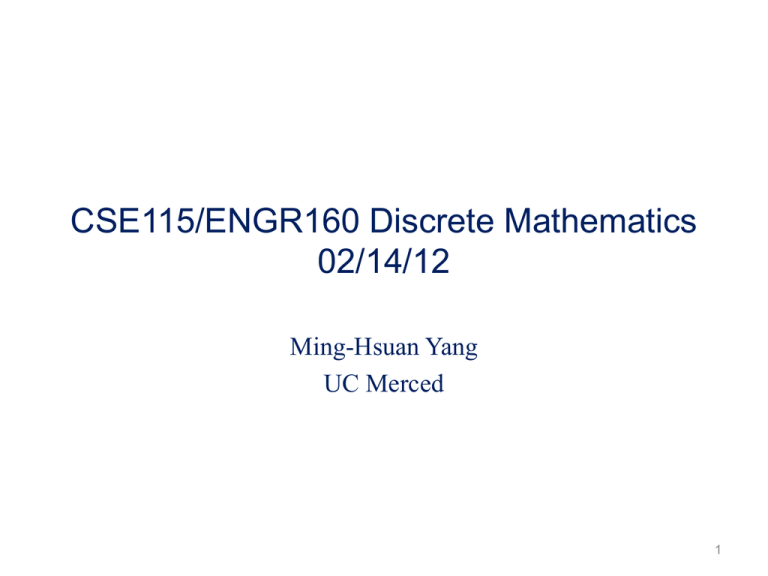
CSE115/ENGR160 Discrete Mathematics
02/14/12
Ming-Hsuan Yang
UC Merced
1
2.2 Set operations
• Union: the set that contains those elements
that are either in A or in B, or in both
A B {x | x A x B}
• A={1,3,5}, B={1,2,3}, A⋃B={1,2,3,5}
2
Intersection
• Intersection: the set containing the elements
in both A and B
A B {x | x A x B}
• A={1,3,5}, B={1,2,3}, A⋂B={1,3}
3
Disjoint set
• Two sets are disjoint if their intersection is ∅
• A={1,3}, B={2,4}, A and B are disjoint
• Cardinality: | A B || A | | B | | A B |
4
Difference and complement
• A-B: the set containing those elements in A
but not in B A B {x | x A x B}
• A={1,3,5},B={1,2,3}, A-B={5}
5
Complement
• Once the universal set U is specified, the
complement of a set can be defined
• Complement of A: A {x | x A}, A U A
• A-B is also called the complement of B with
respect to A
6
Example
• A is the set of positive integers > 10 and the
universal set is the set of all positive integers,
then A {x | x 10} {1,2,3,4,5,6,7,8,9,10}
• A-B is also called the complement of B with
respect to A
7
Set identities
8
Example
• Prove A B A B
• Will show that A B A B and A B A B
• (→): Suppose that x A B , by definition of
complement and use De Morgan’s law
( x A x B)
(( x A)) (( x B))
( x A) ( x B)
• By definition of complement x A or x B
• By definition of union x A B
9
Example
•
•
•
•
•
(←): Suppose that x A B
By definition of union x A x B
By definition of complement x A x B
Thus ( x A) ( x B)
By De Morgan’s law: ( x A) ( x B)
( x A x B)
( x ( A B))
• By definition of complement, x A B
10
Builder notation
• Prove it with builder notation
A B {x | x A B} (def of complement)
{x | ( x ( A B))} (def of not belong t o)
{x | ( x A x B)} (def of int ersecton)
i
{x | ( x A) ( x B )} (De Morgan's law)
{x | x A x B} (def of not belong t o)
{x | x A x B} (def of complement)
{x | x A B} (def of union)
A B
11
Example
• Prove A ( B C ) ( A B) ( A C )
• (→): Suppose that x A ( B C ) then x A
and x B C . By definition of union, it
follows that x A , and x B or x C .
Consequently, x A and x B or x A and x C
• By definition of intersection, it follows x A B
or x A C
• By definition of union, x ( A B) ( A C )
12
Example
• (←): Suppose that x ( A B) ( A C )
• By definition of union, x A B or x A C
• By definition of intersection, x A and x B ,
or x A and x C
• From this, we see x A , and x B or x C
• By definition of union, x A and x B C
• By definition of intersection, x A ( B C )
13
Membership table
14
Example
• Show that
A (B C) (C B) A
A ( B C ) A B C (De Morgan's law)
A ( B C ) (De Morgan's law)
( B C ) A (commutati
ve law)
(C B) A (commutati
ve law)
15
Generalized union and intersection
• A={0,2,4,6,8}, B={0,1,2,3,4}, C={0,3,6,9}
• A⋃B⋃C={0,1,2,3,4,6,8,9}
• A⋂B⋂C={0}
16
General case
•
•
•
•
•
n
Union: A A A A
Intersection A A A A
Union: A A A A
Intersection: A A A A
Suppose Ai={1, 2, 3,…, i} for i=1,2,3,…
1
2
n
1
i
i 1
n
2
n
i 1
1
2
n
1
i 1
i 1
i
i 1
2
i
n
i 1
i
A
{
1
,
2
,
3
,
,
i
}
{
1
,
2
,
3
,
}
Z
i
A {1,2,3,, i} {1}
i 1
i
i 1
17
Computer representation of sets
• U={1,2,3,4,5,6,7,8,9,10}
• A={1,3,5,7,9} (odd integer ≤10),B={1,2,3,4,5}
(integer ≤5)
• Represent A and B as 1010101010, and
1111100000
• Complement of A: 0101010101
• A⋂B: 1010101010˄1111100000=1010100000
which corresponds to {1,3,5}
18




